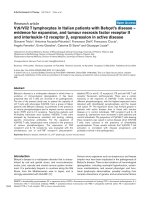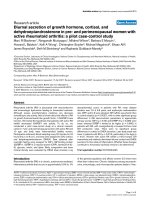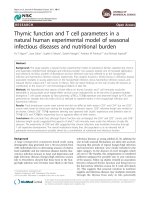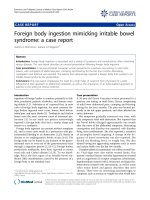Báo cáo y học: " Pituitary hypoplasia and growth hormone deficiency in a woman with glycogen storage disease type Ia: a case report" docx
Bạn đang xem bản rút gọn của tài liệu. Xem và tải ngay bản đầy đủ của tài liệu tại đây (199.14 KB, 4 trang )
BioMed Central
Page 1 of 4
(page number not for citation purposes)
Journal of Medical Case Reports
Open Access
Case report
Pituitary hypoplasia and growth hormone deficiency in a woman
with glycogen storage disease type Ia: a case report
Selcuk Dagdelen*
1
, Aysegul Atmaca
1
, Ayfer Alikasifoglu
2
and Tomris Erbas
1
Address:
1
Hacettepe University School of Medicine, Department of Endocrinology and Metabolism, Ankara, Turkey and
2
Hacettepe University
School of Medicine, Department of Pediatrics, Ankara, Turkey
Email: Selcuk Dagdelen* - ; Aysegul Atmaca - ;
Ayfer Alikasifoglu - ; Tomris Erbas -
* Corresponding author
Abstract
Introduction: Growth retardation is one of the cardinal manifestations of glycogen storage
disease type Ia. It is unclear which component of the growth hormone and/or insulin-like growth
factor axis is primarily disrupted, and management of growth impairment in these patients remains
controversial. Here we report the first case in the literature where glycogen storage disease type
Ia is associated with pituitary hypoplasia and growth hormone deficiency.
Case presentation: A 20-year-old woman with glycogen storage disease type Ia was admitted to
our endocrinology department because of growth retardation. Basal and overnight growth
hormone sampling at 2-hour intervals demonstrated low levels; however, provocative testing
revealed a relatively normal growth hormone response. A hypoplastic anterior pituitary with
preserved growth hormone response to provocative testing suggested the possibility of growth
hormone neurosecretory dysfunction and/or primary pituitary involvement.
Conclusion: Pituitary hypoplasia may result from growth hormone-releasing hormone deficiency,
a condition generally known as growth hormone neurosecretory dysfunction. It is an abnormality
with a spontaneous and pulsatile secretion pattern, characterized by short stature, growth
retardation and normal serum growth hormone response to provocative testing. However, in the
case described in this report, a normal although relatively low growth hormone response during
insulin tolerance testing and pituitary hypoplasia suggested that primary pituitary involvement or
growth hormone neurosecretory dysfunction may occur in glycogen storage disease type Ia. This
is a potential cause of growth failure associated with a lower somatotroph mass, and may explain
the variable responsiveness to growth hormone replacement therapy in people with glycogen
storage disease.
Introduction
Growth retardation is one of the cardinal signs and/or
complications of glycogen storage disease type Ia
(GSDIa). However, the underlying mechanism, and there-
fore the management of growth impairment, in these
patients remains controversial. Hyperlacticacidemia,
recurrent hypoglycemia, growth hormone (GH) and/or
insulin-like growth factor (IGF) deficiency, GH and/or
IGF resistance, decreased insulin and increased cortisol
secretions have all been suggested to explain growth retar-
Published: 18 June 2008
Journal of Medical Case Reports 2008, 2:210 doi:10.1186/1752-1947-2-210
Received: 17 January 2008
Accepted: 18 June 2008
This article is available from: />© 2008 Dagdelen et al; licensee BioMed Central Ltd.
This is an Open Access article distributed under the terms of the Creative Commons Attribution License ( />),
which permits unrestricted use, distribution, and reproduction in any medium, provided the original work is properly cited.
Journal of Medical Case Reports 2008, 2:210 />Page 2 of 4
(page number not for citation purposes)
dation in GSDIa [1]. It is not clear, however, at which level
the GH-IGF axis is mainly injured. Avoidance of hypogly-
cemia and hyperlacticacidemia and/or administration of
diazoxide or GH replacement therapy have been reported
to induce growth, but with variable responses in different
patient groups with GSDIa [1-3].
Case presentation
A 20-year-old woman with GSDIa was referred to our
adult outpatient unit because of short stature. She had a
birth weight of 3200 g at a gestational age of 35 weeks. She
had been diagnosed with GSDIa by glucose-6-phos-
phatase enzyme assay and quantitative assessment of gly-
cogen content in a liver biopsy specimen at 7 months of
age, after displaying classic symptoms and findings con-
sistent with GSDIa including hypoglycemia, lactic acido-
sis, dyslipidemia, enlarged liver and spleen and
nephrocalcinosis, without neutropenia. Recurrent
hypoglycemic episodes had been prevented with the use
of uncooked cornstarch and frequent feeding over a 20-
year follow-up period. However, preprandial hyperlacti-
cacidemia and dyslipidemia persisted despite a lack of
hypoglycemia. Initially she grew between -1SD and -2SD.
After the age of 7 years growth gradually slowed until it
was below -2SD at 9 years of age. She had been evaluated
at a pediatric endocrinology department at 14 years of age
for growth retardation and delayed puberty. Normal thy-
roid-stimulating hormone (TSH), follicle-stimulating
hormone (FSH), luteinizing hormone (LH) and subnor-
mal GH responses to thyrotropin-releasing hormone
(TRH), luteinizing hormone-releasing hormone (LHRH)
and GH stimulation (by L-dopa) tests were obtained
respectively (Table 1). Menarche was delayed, but
occurred spontaneously at the age of 16 years. Liver trans-
plantation had been offered, but refused by the members
of her family.
During her current admission at an adult outpatient unit,
her pubertal development was assessed as being com-
plete. She had short stature with a final height of 141 cm
(parental target height: 163 cm). She had no hepatic or
renal dysfunction. Laboratory tests revealed no hypoglyc-
emia, but hyperlacticacidemia and severe dyslipidemia
were seen (low-density lipoprotein = 212 mg/dl, triglycer-
ides = 409 mg/dl, high-density lipoprotein = 27 mg/dl).
Functional evaluation of her pituitary gland was per-
formed with provocative testing and showed normal TSH,
FSH, LH and GH responses to TRH, LHRH and GH stim-
ulation (by insulin-induced hypoglycemia) tests (Table
1). Morphological evaluation by magnetic resonance
imaging (MRI) revealed a hypoplastic adenohypophysis
(anterior pituitary height 3 mm) with no abnormality in
the neurohypophysis.
Spontaneous overnight GH profiling for 12 hours at 2-
hour intervals revealed a mean GH level of 0.16 ng/ml, a
spontaneous absolute GH peak level of 0.37 ng/ml and
the area under curve value (AUC
GH
= mean profile GH ×
Table 1: Endocrine evaluation of the patient at 14 and 20 years of age
Age (years) 14 20
Skeletal age (years) 10 Closed epiphysis
Weight (kg) 25.7 39.8
Height (m) 1.19 1.41
FSH levels (mIU/ml),
(Basal/peak response to LHRH stimulation)
0.90/4.90 9.27/11.6
LH levels (mIU/ml),
(Basal/peak response to LHRH stimulation)
0.70/9.70 9.57/50.9
Estradiol levels (pg/ml),
(Basal/to LHRH stimulated response)
5/20 31.1/315.0
GH levels (ng/ml),
(Basal/peak response to L-Dopa stimulation, following estradiol priming)
0.93/6.10 -
GH levels (ng/ml),
(Basal/peak response to insulin-induced hypoglycemia when the lowest glucose was 26 mg/dl))
- 0.37/5.18
Overnight GH profile (ng/ml),
(Frequent sampling from 10 00 pm to 10 00 am)
- 0.07/0.12/0.37/0.11/0.05/0.24
IGFBP3(ng/ml) 2941 -
Basal IGF1 (ng/ml) 17.5 50.8
TSH levels (mU/ml),
(Basal/peak response to TRH stimulation)
4.6/14.5 4.57/21.97
Basal FT4 (pmol/l) 16.7 12.71
Cortisol levels (μg/dl)
(Basal/peak response to insulin-induced hypoglycemia)
- 9.9/20.2
Normal values for basal growth hormone (GH): 0 to 7 ng/ml; insulin-like growth factor1 (IGF1), for 12- to 15-year-old girls: 261 to 1096 ng/ml, for
16- to 24-year-old women: 182 to 780 ng/ml; insulin-like growth factor binding protein 3 (IGFBP3), for 7 to 39 year olds: 1250 to 7330 ng/ml;
normal GH response to insulin-induced hypoglycemia >5.0 ng/ml; severe GH deficiency in insulin-induced hypoglycemia <3.0 ng/ml; normal GH
response to L-Dopa >10 ng/ml.
Journal of Medical Case Reports 2008, 2:210 />Page 3 of 4
(page number not for citation purposes)
time) for the night was 115 ng*min/ml (Table 1). Day-
time and more frequent overnight GH samplings were
offered, but not accepted by the patient.
Discussion
To the best of our knowledge, hypoplastic adenohypoph-
ysis in GSDIa has not been described previously. Melis et
al. previously investigated brain MRI findings in patients
with GSDI, and showed that 57.1% of the patients had an
altered brain MRI pattern [4]. There was no mention in
their study of pituitary abnormality or a hypothalamopi-
tuitary imaging pattern [4].
Kuemmerle et al. showed that sustained metabolic acido-
sis causes growth inhibition in rats by decreasing the
amplitude and mean mass of GH pulses [5]. As metabolic
(hypoxic) injuries of the hypothalamus are also known to
cause hypoplasia of the anterior pituitary, the hypoplastic
adenohypophysis in the woman described in this case
report is considered to be related to growth hormone neu-
rosecretory dysfunction (GHNSD) [6]. GHNSD is an
abnormality characterized by short stature, growth retar-
dation and abnormal spontaneous GH secretion despite
normal GH response to provocative testing [7]. Our case
would formally have satisfied the diagnostic criteria for
GHNSD, with a further finding of hypoplastic adenohy-
pophysis. While prepubertal dynamic testing revealed a
subnormal GH response, but not severe GH deficiency
(that is, stimulated GH response <3 ng/ml), a normal
peak GH response was obtained in her re-evaluation using
an insulin-tolerance test when she was 20 years old. Such
a discrepancy between childhood and adulthood peak
GH responses have already been reported in GHNSD [8].
A more frequent sampling than the limited 2-hour inter-
vals undertaken in our case may have detected significant
peaks, especially overnight. Spontaneous GH secretion
may have been underestimated here.
On the other hand, the existence of GHNSD as a separate
entity has been questioned recently in one paper [9]. In
this study, which was entirely focused on GH abnormali-
ties following cranial irradiation, it was concluded that a
reduced somatotroph reserve might mimic or seemingly
present as GHNSD when hypothalamic compensation
fails to restore GH secretion in the case of increased
demands such as puberty [9]. As growth hormone-releas-
ing hormone (GHRH) also functions as a trophic factor
for the pituitary gland, an atrophic or hypoplastic pitui-
tary associated with discordant spontaneous and stimu-
lated GH secretion patterns is generally considered as
GHRH deficiency due to GHNSD.
A normal stimulated GH response in an insulin-tolerance
test is defined as a peak of above 5.0 ng/ml [10]. Although
the stimulated GH level of 5.18 ng/ml in our case was just
above the cut-off level, it could still be considered as a rel-
atively low response due to lack of normative data for
GSDIa. If so, the reduction in both the spontaneous and
stimulated GH secretion, which is proportional to soma-
totroph volume, may be a reflection of primary pituitary
hypoplasia rather than GHNSD.
As described and demonstrated by Darzy et al. in cranial
irradiation, the possibility of primary loss in the soma-
totroph mass, rather than secondary atrophy due to a neu-
rosecretory defect in GHRH secretion, should also be
considered, especially in patients with an underlying
injury which is potentially harmful to the pituitary gland
itself [9]. Although there is a lack of evidence, it is possible
that GSDIa may have an associated genetic involvement
of the pituitary gland which has not yet been defined.
Conclusion
We have reported the case of an adult patient with GSDIa
in whom GH deficiency was associated with pituitary
hypoplasia, and who had a relatively normal GH response
to provocative testing, but not classical of GHNSD. In
addition to the IGF1 deficiency resulting from primary
hepatic involvement, GSDIa also seems to disrupt the
hypothalamic-pituitary axis. To clarify whether the pitui-
tary hypoplasia described in this case is a primary occur-
rence caused by an unknown mechanism, or a secondary
event as GHNSD, requires further studies to test spontane-
ous and stimulated GH secretion patterns in people with
GSDIa.
Abbreviations
FSH: follicle-stimulation hormone; GH: growth hor-
mone; GHNSD: growth hormone neurosecretory dysfunc-
tion; GHRH: growth hormone-releasing hormone;
GSDIa: glycogen storage disease type Ia; IGF: insulin-like
growth factor; LH: luteinizing hormone; LHRH: luteiniz-
ing hormone-releasing hormone; MRI: magnetic reso-
nance imaging; TRH: thyrotropin-releasing hormone;
TSH: thyroid-stimulating hormone.
Competing interests
The authors declare that they have no competing interests.
Consent
Written informed consent was obtained from the patient
for publication of this case report and any accompanying
images. A copy of the written consent is available for
review by the Editor-in-Chief of this journal.
Authors' contributions
All authors contributed equally to this report. All authors
read and approved the final manuscript.
Publish with BioMed Central and every
scientist can read your work free of charge
"BioMed Central will be the most significant development for
disseminating the results of biomedical research in our lifetime."
Sir Paul Nurse, Cancer Research UK
Your research papers will be:
available free of charge to the entire biomedical community
peer reviewed and published immediately upon acceptance
cited in PubMed and archived on PubMed Central
yours — you keep the copyright
Submit your manuscript here:
/>BioMedcentral
Journal of Medical Case Reports 2008, 2:210 />Page 4 of 4
(page number not for citation purposes)
References
1. Mundy HR, Hindmarsh PC, Matthews DR, Leonard JV, Lee PJ: The
regulation of growth in glycogen storage disease type 1. Clin
Endocrinol (Oxf) 2003, 58:332-339.
2. Nuoffer JM, Mullis PE, Wiesmann UN: Treatment with low-dose
diazoxide in two growth-retarded prepubertal girls with gly-
cogen storage disease type Ia resulted in catch-up growth. J
Inherit Metab Dis 1997, 20:790-798.
3. Noto RA, Vijayaraghavan V, Timoshin A, Sansobrino D: Improved
growth with growth hormone therapy in a child with glyco-
gen storage disease Ib. Acta Paediatr 2003, 92:977-979.
4. Melis D, Parenti G, Della Casa R, Sibilio M, Romano A, Di Salle F, Ele-
fante R, Mansi G, Santoro L, Perretti A, Paludetto R, Sequino L, Andria
G: Brain damage in glycogen storage disease type I. J Pediatr
2004, 144:637-642.
5. Kuemmerle N, Krieg RJ Jr, Latta K, Challa A, Hanna JD, Chan JC:
Growth hormone and insulin-like growth factor in non-ure-
mic acidosis and uremic acidosis. Kidney Int Suppl 1997,
58:S102-105.
6. Spampinato MV, Castillo M: Congenital pathology of the pitui-
tary gland and parasellar region. Top Magn Reson Imaging 2005,
16:269-276.
7. Spiliotis BE, August GP, Hung W, Sonis W, Mendelson W, Bercu BB:
Growth hormone neurosecretory dysfunction. A treatable
cause of short stature. JAMA 1984, 251:2223-2230.
8. Aimaretti G, Baffoni C, Bellone S, Di Vito L, Corneli G, Arvat E, Benso
L, Camanni F, Ghigo E: Retesting young adults with childhood-
onset growth hormone (GH) deficiency with GH-releasing-
hormone-plus-arginine test. J Clin Endocrinol Metab 2000,
85:3693-3699.
9. Darzy KH, Pezzoli SS, Thorner MO, Shalet SM: Cranial irradiation
and growth hormone neurosecretory dysfunction: a critical
appraisal. J Clin Endocrinol Metab 2007, 92:1666-1672.
10. Ghigo E, Aimaretti G, Corneli G: Diagnosis of adult GH defi-
ciency. Growth Horm IGF Res 2008, 18:1-16.









